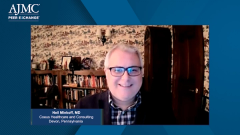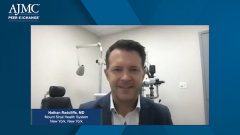
Goals of Therapy When Treating Glaucoma
Experts highlight early detection and the goals of therapy when managing patients with glaucoma.
Episodes in this series

Transcript:
Neil Minkoff, MD: We’ve done the education and we have the primary care physician referring the patient appropriately, the patients are getting in earlier than they’re currently getting in at least. Dr Pickering, let me ask you, what do we do? When you’re talking to a bunch of folks like me, how do you describe what your goal is for early detection and what are your goals for therapy?
Terri-Diann Pickering, MD: My goal for early detection is to keep the patient from even noticing that they have glaucoma. In other words, preserve all the visual field that they have when they come to me. My overarching goals of therapy [is] number 1, I want to prevent blindness. Part of the problems that Dr Radcliffe and I have, since we’re both glaucoma specialists, is that we see very end-stage disease. I want to keep my patients with some vision before they die. Secondarily though, I’d like them to keep functional vision, especially the lower visual field. Can they see well enough to walk downstairs? Can they read? For our fortunate patients, are they still able to drive? And third of all, I want to preserve quality of life so that the treatments that we have, whether it’s drops, laser, or surgery, don’t impact them negatively that they don’t adhere to treatment and then worsen, or that they’re sort of miserable. All 3 of these are done by controlling intraocular pressure, IOP, in a way that the patients find tolerable, acceptable, and easy to fit in with their lifestyle. But right now, lowering intraocular pressure is the only approved method we have for treating glaucoma.
Neil Minkoff, MD: Dr Radcliffe, anything to add to that?
Nathan Radcliffe, MD: Yes, we’ll probably be getting into this. Treating glaucoma is not without a negative quality of life impact. There’s practical issues. There’s some cost to the patient. There’s some adverse effects to our treatments. We want to, on some level, preserve their entire quality of life. On another level, we’re balancing the negative impact of our therapy with the vision-related quality of life benefit of vision preservation. Particularly, for the glaucoma specialist with these severe cases, it gets difficult because we use multi-drug therapy. We have to do surgery. And there is a bit of morbidity to the treatment late in the disease. Early in the disease, we have wonderful therapies with brilliant adverse effect profiles that are even inexpensive, and it’s a very good model for early detection and prevention. And where everybody wins—payor, patient, physician. Everyone’s life is easier when we get to this disease early and initiate therapy before it’s severe.
Neil Minkoff, MD: I want to come back to that because effective and inexpensive sounds like a managed care dream. I’m going to circle back around to that. But I do want to ask Dr Lopes, are you measuring anything regarding these patients? When I talk about population health, you’ve brought up Stars measures and said HEDIS [Healthcare Effectiveness Data and Information Set] measures. Many of us have been under a great deal of, let’s say have put in a great deal of effort to make sure our HbA1c low-density lipoprotein [glycosylated hemoglobin] levels are measured, and LDL [low-density lipoprotein] levels are measured, and blood pressure levels are measured. Are there any measures that you’re tracking here?
Maria Lopes, MD, MS:We’re not tracking IOP control. If there were such a measure, then we would certainly be following IOP and is within normal range or maybe even look at adherence to treatments or nonadherence to treatments. But, at this point, it’s not a HEDIS measure. Payors want it to be evidence based, and we certainly don’t want to be in the way of effective treatments or surgery, and usually the treatment options available are on, either they’re tiered, there’s a formulary in place which is going to have a lot to do with patient affordability. There’s very little prior authorization in this area except for maybe some of the newer plans. But, otherwise, we try to, especially with generics that are available, they’re on the lowest cost share tier, and certainly we don’t want to have barriers to access for very effective treatment options, different mechanisms of action which oftentimes must be used in combination. We want to let physicians be in control of the prescribing, as well as being able to adjust medications appropriately.
Transcript edited for clarity.
Newsletter
Stay ahead of policy, cost, and value—subscribe to AJMC for expert insights at the intersection of clinical care and health economics.


































































